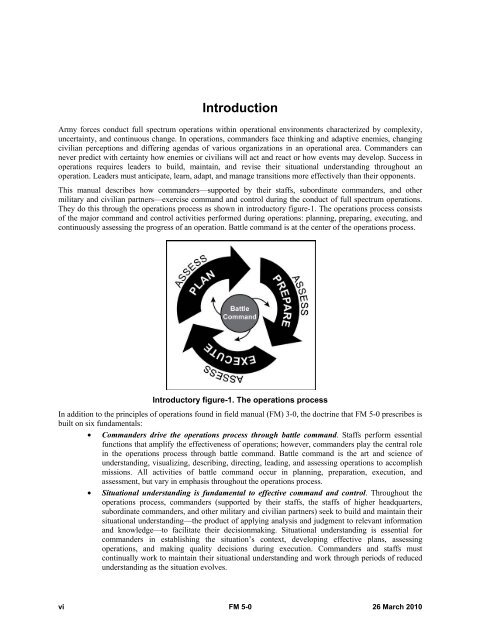FM 5-0, The Operations Process - Federation of American Scientists
FM 5-0, The Operations Process - Federation of American Scientists
FM 5-0, The Operations Process - Federation of American Scientists
You also want an ePaper? Increase the reach of your titles
YUMPU automatically turns print PDFs into web optimized ePapers that Google loves.
Introduction<br />
Army forces conduct full spectrum operations within operational environments characterized by complexity,<br />
uncertainty, and continuous change. In operations, commanders face thinking and adaptive enemies, changing<br />
civilian perceptions and differing agendas <strong>of</strong> various organizations in an operational area. Commanders can<br />
never predict with certainty how enemies or civilians will act and react or how events may develop. Success in<br />
operations requires leaders to build, maintain, and revise their situational understanding throughout an<br />
operation. Leaders must anticipate, learn, adapt, and manage transitions more effectively than their opponents.<br />
This manual describes how commanders—supported by their staffs, subordinate commanders, and other<br />
military and civilian partners—exercise command and control during the conduct <strong>of</strong> full spectrum operations.<br />
<strong>The</strong>y do this through the operations process as shown in introductory figure-1. <strong>The</strong> operations process consists<br />
<strong>of</strong> the major command and control activities performed during operations: planning, preparing, executing, and<br />
continuously assessing the progress <strong>of</strong> an operation. Battle command is at the center <strong>of</strong> the operations process.<br />
Introductory figure-1. <strong>The</strong> operations process<br />
In addition to the principles <strong>of</strong> operations found in field manual (<strong>FM</strong>) 3-0, the doctrine that <strong>FM</strong> 5-0 prescribes is<br />
built on six fundamentals:<br />
• Commanders drive the operations process through battle command. Staffs perform essential<br />
functions that amplify the effectiveness <strong>of</strong> operations; however, commanders play the central role<br />
in the operations process through battle command. Battle command is the art and science <strong>of</strong><br />
understanding, visualizing, describing, directing, leading, and assessing operations to accomplish<br />
missions. All activities <strong>of</strong> battle command occur in planning, preparation, execution, and<br />
assessment, but vary in emphasis throughout the operations process.<br />
• Situational understanding is fundamental to effective command and control. Throughout the<br />
operations process, commanders (supported by their staffs, the staffs <strong>of</strong> higher headquarters,<br />
subordinate commanders, and other military and civilian partners) seek to build and maintain their<br />
situational understanding—the product <strong>of</strong> applying analysis and judgment to relevant information<br />
and knowledge—to facilitate their decisionmaking. Situational understanding is essential for<br />
commanders in establishing the situation’s context, developing effective plans, assessing<br />
operations, and making quality decisions during execution. Commanders and staffs must<br />
continually work to maintain their situational understanding and work through periods <strong>of</strong> reduced<br />
understanding as the situation evolves.<br />
vi <strong>FM</strong> 5-0 26 March 2010















